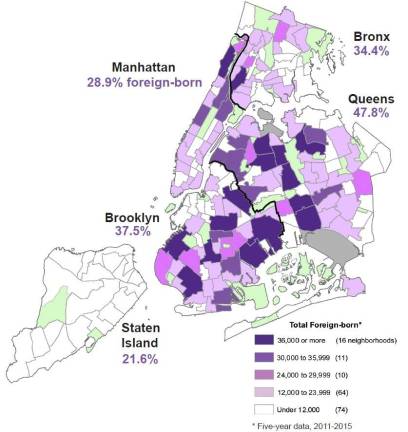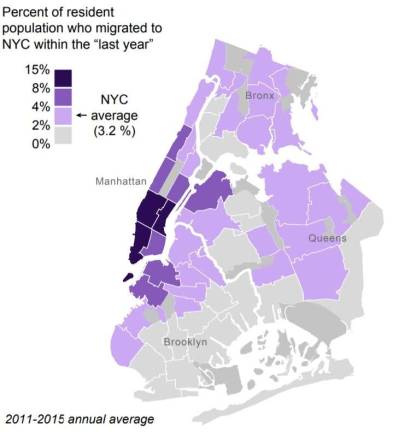Census 2020: 4 key Questions for NYC


The 2020 U.S. Census is still two years away, but New York City’s preparations for the decennial count have already begun in earnest.
Focus on the census has been amplified in recent weeks in response to concerns that the potential inclusion of a question about citizenship status could depress turnout among the city’s 3.2 million immigrants.
City officials detailed the most significant census-related issues facing New York at an April 3 forum hosted by CUNY Journalism School’s Center for Community and Ethnic Media. Four key questions:
WHAT’S AT STAKE?The census aims to count every resident of the country every ten years and is mandated by the Constitution. Seats in the House of Representatives are apportioned to each state based on the results.
The city and state use the data to determine where to direct resources and project future needs for infrastructure, education and other critical areas. “In order for any government to provide services it has to know who it’s serving,” said Marisa Lago, director of the New York City Department of City Planning.
Census data is also used by the federal government in determining how to distribute funding for programs among the states. “The federal government funnels $53 billion to New York state through programs that are dependent upon the census,” Lago said, noting that population-based formulas govern funding allocations for a diverse array of federal programs, including school breakfasts for low-income students, funding to support people with disabilities and homeland security.
WHY IS NYC A CHALLENGE FOR CENSUS TAKERS?“Urban areas — and in particular, poorer urban areas — are notoriously hard to enumerate properly,” Lago said.
J. Phillip Thompson, Deputy Mayor for Strategic Policy Initiatives, said that the city conducts extensive outreach efforts to engage communities that might otherwise not participate in the census. “I think New York is always undercounted, and one reason is that we have a large number of doubled-up households in New York City, and those folks are scared to report to the landlord [that] they’re on the lease,” Thompson said.
Suspicion among immigrant populations of submitting personal information to the government, homelessness, language barriers and informal housing arrangements like illegal basement dwellings and subdivided apartments are a few of the challenges facing census enumerators, who are tasked with counting individuals regardless of their legal or residential status.
“The census doesn’t care about the legality of where you live, it just wants to know where people live,” Lago said.
WHAT STEPS DOES THE CITY TAKE TO ENSURE AN ACCURATE COUNT?Demographers within the Department of City Planning work closely with the U.S. Census Bureau to disseminate the census to as many residents as possible. The starting point for the distribution of census forms is a list of addresses compiled by the Census Bureau, which the city works to bolster.
“The census is mailed to addresses,” Lago said. “If the Census Bureau doesn’t have your address, you’re never going to get the form and you don’t have the possibility of being counted.”
The city sends staff into the field to search for addresses not included in the list provided by the Census Bureau, looking for signs of residences in commercial districts and other nonresidential areas, which might include extra doorbells or satellite dishes.
“We are able to report back to the Census Bureau around 100,000 additional addresses,” Lago said.
After the census officially kicks off in March 2020, the Department of City Planning will work with the Census Bureau in real time to monitor response rates and request that resources be directed toward increasing engagement in areas where undercounting is suspected.
“We as a city and other urban areas are always going to be tougher to enumerate than a wealthy suburb,” Lago said. “This year though, we have the additional overlay of a federal climate that is hostile to immigrants, coupled with the citizenship question.”
IF THE CITIZENSHIP QUESTION IS INCLUDED, WILL UNDOCUMENTED IMMIGRANTS BE AT INCREASED RISK OF DEPORTATION BY PARTICIPATING IN THE CENSUS?On March 26, Commerce Secretary Wilbur Ross directed the Census Bureau to include a question about respondents’ citizenship in the 2020 Census. “Prior decennial census surveys of the entire United States population consistently asked citizenship questions up until 1950, and Census Bureau surveys of sample populations continue to ask citizenship questions to this day,” Ross wrote in a memo on the decision.
The Justice Department requested that the question be included on the grounds that it would help enforce the Voting Rights Act, but critics have said it is intended to decrease immigrant turnout and impact congressional apportionment.
Thompson called the Voting Rights Act explanation “entirely specious.”
“This seems to be nothing else than a partisan political move aimed at cities like New York and other cities with large immigrant populations, to try and bolster one political party’s power over another,” Thompson said.
New York City was home to 3.2 million immigrants as of 2015 — 38 percent of the city’s total population — an estimated 750,000 of whom were undocumented. Roughly one million households in the city include at least one undocumented person.
Census data is aggregated and anonymized, and individual responses are subject to strict confidentiality protections. The city will work to inform immigrant communities of these protections and combat the misconception that citizenship data could be used by U.S. Immigration and Customs Enforcement to target immigrants for deportation.
“ICE has its own data,” said Bitta Mostofi, acting commissioner of the Mayor’s Office of Immigrant Affairs.
“They know where immigrant populations live,” Mostofi said. “They don’t need to rely on the census for that information. This is more about the chilling effect and fear that it is intended to perpetuate and less about, frankly, their need for such information — they have that.”
City officials will focus on educational efforts to inform immigrants that completing the census does not put them at increased risk. “I think the intent of including the question is to drive immigrants underground, and the best way to fight that is actually to stand up and be counted and to resist that effort to try and make immigrants invisible,” Thompson said.